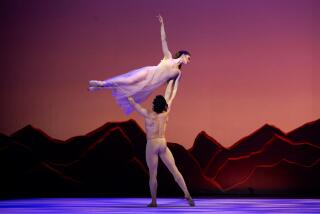A gloss-free ‘Giselle’
- Share via
The Royal Ballet closed its six-day engagement at the Orange County Performing Arts Center on Saturday with two fine performances of Peter Wright’s studiously anti-Romantic staging of “Giselle.”
The matinee belonged to Albrecht: the distinctively noble, passionate, virtuosic Ivan Putrov. The evening belonged to Giselle: the disarmingly fluid, buoyant, refined Alina Cojocaru. Both Saturday “Giselles” also boasted detailed, authoritative mime from Genesia Rosato (playing Giselle’s mother in the afternoon, Albrecht’s fiancee at night), a superb 24-member corps of Wilis and cohesive leadership of the Pacific Symphony by Boris Gruzin.
Filled with uncredited choreographic emendations and switches in the traditional sequencing of dances, Wright’s production placed the action in a naturalistic world devoid of conventional balletic prettiness.
John F. Macfarlane’s designs created a messy workaday village and a storm-battered forest, with earth tones and black predominant, and blues and greens relegated to only the faintest washes on tights.
In this dusty, uninviting environment, Giselle’s openhearted sweetness made her very special indeed.
No wonder this childlike dreamer took refuge in dancing and fell for Albrecht instead of Hilarion. At least he shaved....
Intent on making the plot follow a logical course, Wright sometimes grew anti-musical, especially at the very beginning when Albrecht’s bold entrance clashed with the bucolic scene-painting of the score by Adolphe Adam and others.
Wright also copped out with the standard sentimental ending -- Albrecht distraught and alone -- instead of the original one in which Giselle gives him back his future as well as his life.
Wright’s synopsis said that Giselle kills herself, a mortal sin explaining why she’s buried in the forest rather than a churchyard. But the two Saturday Giselles -- like most interpreters of the role -- died of a heart attack, though Cojocaru, at least, did convincingly stab at herself.
Putrov’s energy and urgency as a dancing actor made his involvement in the mad scene one of Wright’s best innovations, and he danced superbly throughout.
Opposite him, Roberta Marquez tended to snap from one position to the next and dramatically generalize the role. However, her technical command never faltered and she did execute all of Giselle’s hops on pointe in Act 1: a feat that Cojocaru avoided.
But Cojocaru managed to float through all of Act 2 as if on a single breath, deeply in touch with the musical impulse at all times and quite perfect in placement.
Moreover, her impetuous approach in Act 1 -- a girl caught up in a torrent of events -- carried her and the audience on a wave of happy expectation to the crushing reality of the mad scene.
As Albrecht, Johan Kobborg partnered her lovingly, tossed off bravura step combinations and produced plenty of intensity where needed. But somehow the components of his portrayal didn’t add up. As in his performance on Monday in “Cinderella,” he displayed all the skills he needed as a classical dancer, but not the instincts that proclaim innate ballet royalty.
Vanessa Palmer danced Myrta powerfully and steadily at the matinee; at night, Mara Galeazzi began weakly but gained force as the dancing continued. Bennet Gartside and Martin Harvey each made sympathetic Hilarions, the former (in the afternoon) more thoughtful, the latter (in the evening) more fiery.
Harvey also joined Lauren Cuthbertson in the pas de deux of the peasant sextet in Act 1: charming, stylish and utterly satisfying, unless you happened to see Laura Morera and Ricardo Cervera stop “Giselle” cold with their brilliance later the same day.
Ultimately, the Wright/Royal “Giselle” never outclassed the greatest versions of the ballet on view internationally -- the drama of the National Ballet of Cuba or the atmosphere of the Kirov, for starters. But as a vehicle for a magnificent company, and as an experiment in rethinking an over-familiar classic, it confirmed that a saga of love beyond the grave still has legs, and new facets to explore, in its third century.
More to Read
The biggest entertainment stories
Get our big stories about Hollywood, film, television, music, arts, culture and more right in your inbox as soon as they publish.
You may occasionally receive promotional content from the Los Angeles Times.










